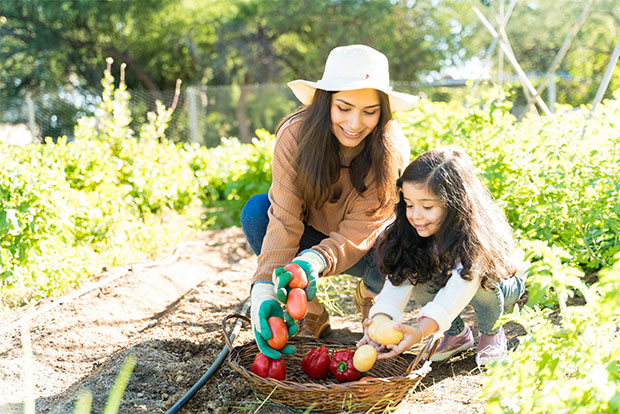6 easy steps to grow a garden
The benefits from gardening are endless — relaxation, fitness, family fun, delicious food and beautifying your lawn. Across the country, millions of people live in townhomes, apartments or single-family homes that seem to lack the outdoor space needed for a conventional garden. But the good news is that no matter where you live you can still create a garden that reflects your goals and is uniquely personal to you.
Raised bed gardens may be the perfect solution. This type of gardening is gaining popularity not only because it can be adjusted to fit any size requirements, but because it is prone to fewer weeds, reduced soil erosion and fewer soil challenges that can arise in areas where the ground is inherently sandy or clay-based. Raised bed gardens also offer you the opportunity to customize your garden bed with beautiful accents and decorations that will make it look as amazing as the food it produces.
STEPS FOR GROWING VEGGIES AND HERBS IN A RAISED GARDEN BED
• Step 1: Prep your space.
Raised garden beds can be bought or built to fill whatever space you have available. Select a bed that works well with your space and prepare accordingly.
• Step 2: Choose your soil. Once you have your empty bed ready, choose your soil. Nature’s Care Raised Bed Soil is ideal as this soil is specifically formulated with rich organic matter and high-quality nutrients that help give your plants the benefits they need with no mixing required. Once you add the soil, be sure to rake it so it is smooth and level.
• Step 3: Preparing your bed. Next, you can finalize what you want to plant. Spacing is essential here and you want to remember to place your plants close together for maximum yield. Bonnie Plants provides a number of delicious and colorful options, including basil, tomato, kale, hot peppers and more. Check out your local plant nurseries for a variety of Bonnie Plants to choose from.
• Step 4: Planting. Since plant spacing varies by plant type, read the back of the plant tag for proper plant spacing.
• Step 5: Feed your plants. Once your veggies and herbs are planted, apply a fertilizer such as Nature’s Care Organic & Natural Raised Bed Plant Food to add essential nutrients to the soil and help your plants grow big and strong. Simply sprinkle and work into the soil, then treat your plants to water. Just like us, plants get hungry, so make sure you follow the directions on the label to determine when to reapply.
• Step 6: Harvest. When your vegetables are ripe, it’s time to harvest. All you need to do is rinse and then you are ready to enjoy your favorite recipe.
For more information on growing veggies and herbs in a raised bed garden and other gardening tips and tricks, visit naturescare.com.
This article is courtesy of Brandpoint.

